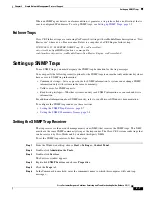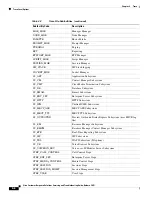
4-2
Cisco Customer Response Solutions Servicing and Troubleshooting Guide, Release 5.0(1)
Chapter 4 Trace
The Component Trace File
The Component Trace File
You can create a trace file for any of the following Cisco CRS components:
•
Cisco CRS Engine
•
Cisco CRS Administration
•
Cisco CRS Editor
•
Cisco CRS Node Manager
•
Cisco CRS SQL Server
The component trace file contains information about each of the component's subfacilities. To set up this
trace file, you perform the following general procedures:
•
Configuring the Component Trace File, page 4-2
•
Trace Level Options, page 4-3
For information about reading the trace file, see the
Viewing and Interpreting the Trace Files, page 4-8
Configuring the Component Trace File
By default, the Cisco CRS system sends information about subfacilities toa trace file, for example,
CiscoMIVRnn.log. The system replaces nn with a number, starting with 01. You can configure the size
of the trace file. When the size you configured is reached, or if a Cisco CRS component is restarted, the
system creates a new trace file, incrementing nn by one. After creating the tenth trace file (by default),
the trace file begins overwriting existing files, starting with the first trace file created.
Note that the examples shown here are for the Cisco CRS Engine component. Follow the same
procedures for the other components, substituting the component's name.
To change any of these default trace file parameters, follow these steps:
Step 1
From the Cisco CRS Administration menu, choose
System > Tracing
.
The Trace Configuration page appears.
Step 2
Choose and expand a component from the navigation bar.
Step 3
Change the following information under Trace File as needed:
•
Trace File Output—Check this check box to send information to a trace file. Uncheck this box if you
do not want to send information to a trace file. By default, this check box is checked.
•
File Name—Enter the base name and the extension of the trace file. A trace file name is made up of
the base facility name, the file number, and the extension (for example, CiscoMIVR01.log). The
default file name is
Cisco<facility_code>.log
where the <
facility_code>
could be MIVR, MCVD, MADM, MEDT, or MARC.
•
Number of Trace Files—Enter the number of trace files that the system will create before starting
to overwrite existing files. The system will create a new trace file each time the existing one reaches
the size specified in the Trace File Size field. The default number of trace files is 10.
•
Trace File Size—You can configure the file size, or you can enter the maximum size, in bytes, of the
trace file. The default files size is 1048576.
Содержание Cisco Unified Queue Manager
Страница 12: ...Contents x Cisco Customer Response Solutions Servicing and Troubleshooting Guide Release 5 0 1 ...
Страница 21: ...P A R T I Serviceability ...
Страница 22: ......
Страница 61: ...P A R T I I Troubleshooting ...
Страница 62: ......
















































